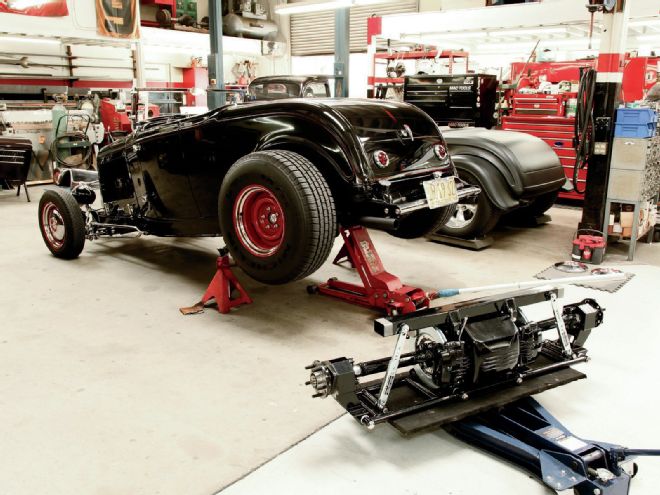
When you've operated a successful business for more than 45 years, chances are good everyone will know your name. Such is the case with the name Kugel, as in Kugel Komponents, which is most widely known for building independent front and rear suspension systems for hot rods.
But that wasn't always the case because before Jerry Kugel started his business in 1969, he was a mechanic and machinist who liked to solve problems. Working on a basket-case 1932 roadster that he'd purchased for $1,000, he wanted to install a Ford motor but didn't want to cut up the pristine firewall. He saw that if the shaft in the stock Ford water pump could be cut down, it would fit so the firewall wouldn't need to be cut and, once an article by Bud Bryan appeared in Rod & Custom magazine showing how he'd done it, Kugel found himself in business modifying water pumps.
But another aspect of Kugel's roadster caught people's attention. Kugel also noticed how, with its caged design, a rear independent suspension system from a Jaguar could fit under a Deuce roadster as a complete unit, and soon others wanted IRS systems for their cars, too. As supplies for vintage Jag suspensions started to dwindle, Kugel started making his own machined components for 9-inch-based independent rearends from blocks of aluminum, and soon another facet of Kugel Komponents was firmly entrenched.
Throughout the past 40-plus years, Kugel Komponents has shied away from doing repair on rodder's vehicles, mostly because they didn't have the time or space needed to devote to it. But more recently they've opened their doors to all sorts of repairs, from engine replacement to brake problems, overheating to electrical problems.
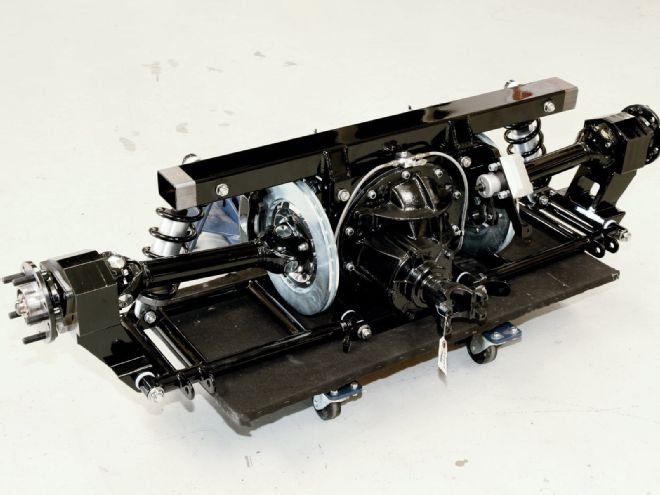 1. This is the base IRS unit from Kugel that sells for about $5,500, though this one has some optional equipment added, such as the single emergency brake, a brake hose junction block kit, and all the parts and pieces powdercoated (which added $1,000 to the bill).
1. This is the base IRS unit from Kugel that sells for about $5,500, though this one has some optional equipment added, such as the single emergency brake, a brake hose junction block kit, and all the parts and pieces powdercoated (which added $1,000 to the bill).
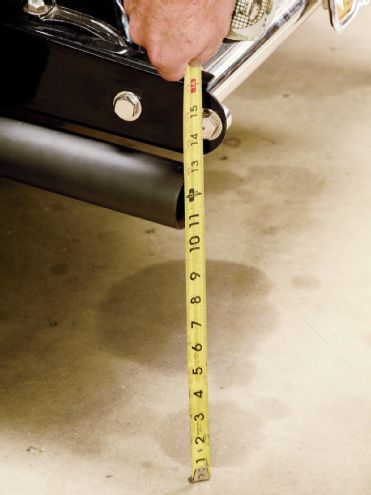 2. Before the installation, measurements were made between the ground and the rear spreader bar bolt (14-3/8 inches)...
2. Before the installation, measurements were made between the ground and the rear spreader bar bolt (14-3/8 inches)...
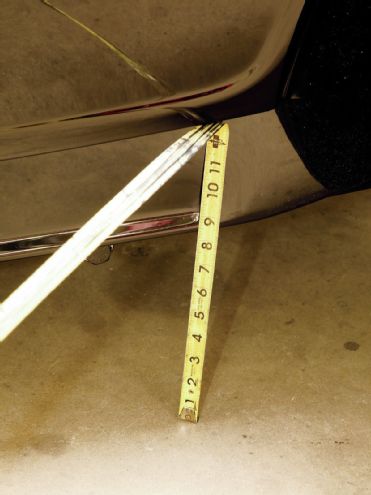 3. ...the end of the framerail reveal (8-1/4 inches)...
3. ...the end of the framerail reveal (8-1/4 inches)...
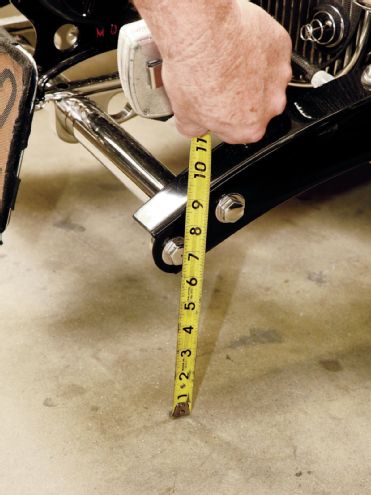 4. ... and the middle of the front spreader bar bolt (6-3/4 inches).
4. ... and the middle of the front spreader bar bolt (6-3/4 inches).
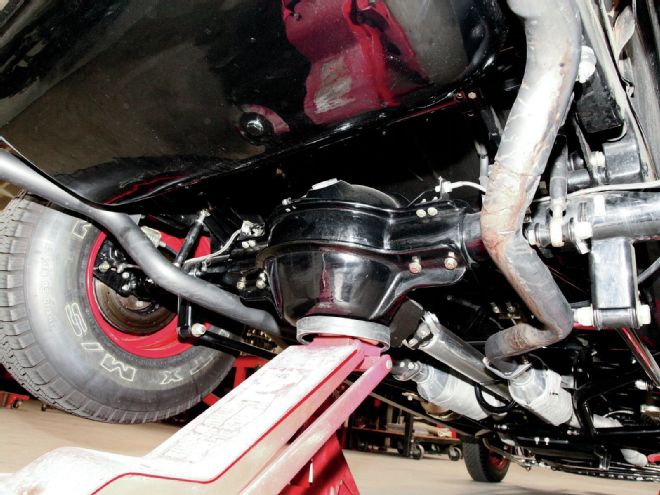 5. Before the old system was removed, you can see how the exhaust tubing was routed under the axle. For a cleaner appearance the new exhaust will route above the half shafts and out of view.
5. Before the old system was removed, you can see how the exhaust tubing was routed under the axle. For a cleaner appearance the new exhaust will route above the half shafts and out of view.
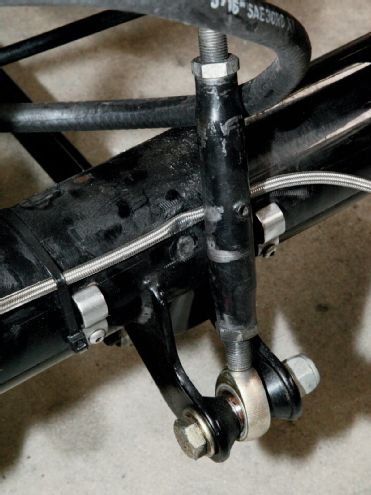 6. Another problem due to the binding of some of the pieces, one of the links for the sway bar was also pinching the braided brake line.
6. Another problem due to the binding of some of the pieces, one of the links for the sway bar was also pinching the braided brake line.
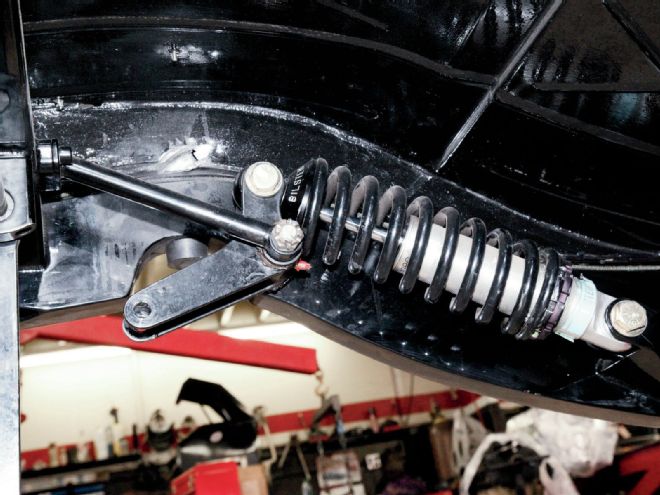 7. The coilover shock in the old IRS design was mounted almost horizontal to the inside of the framerail, and was operated via a rocker arm. Unfortunately, when in use, the shock side of the rocker was digging into the boxed side of the framerail.
7. The coilover shock in the old IRS design was mounted almost horizontal to the inside of the framerail, and was operated via a rocker arm. Unfortunately, when in use, the shock side of the rocker was digging into the boxed side of the framerail.
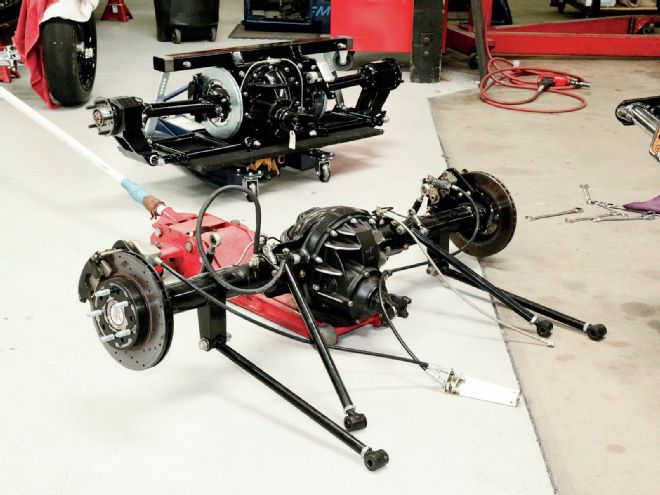 8. The old system in the foreground, with the new Kugel IRS unit in back, ready for installation.
8. The old system in the foreground, with the new Kugel IRS unit in back, ready for installation.
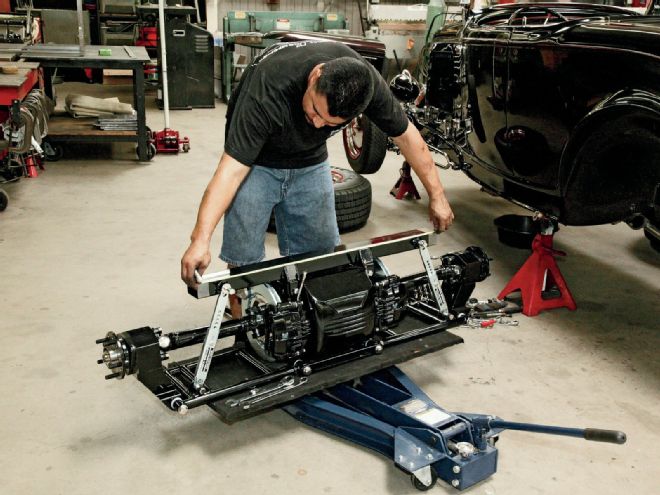 9. Jose Juarez, a fabricator at Kugel Komponents for the past 15 years, double-checks the measurement of the crossmember (from which the rest of the IRS unit hangs) before installation. For a stock ’32 frame, it should be 37-1/2 inches.
9. Jose Juarez, a fabricator at Kugel Komponents for the past 15 years, double-checks the measurement of the crossmember (from which the rest of the IRS unit hangs) before installation. For a stock ’32 frame, it should be 37-1/2 inches.
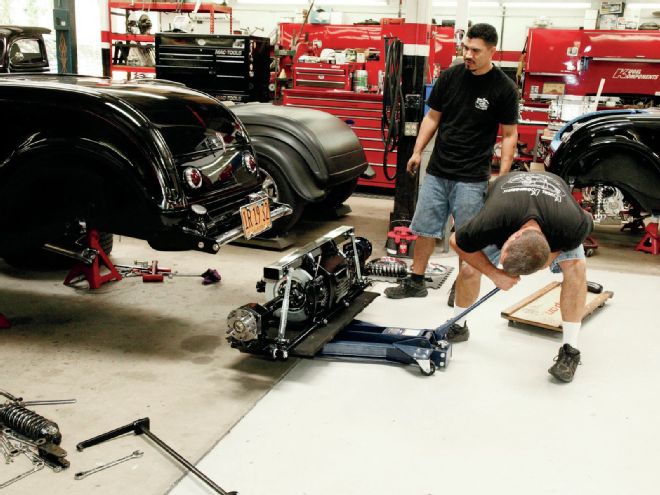 10. Joe Kugel slides the complete IRS system in to determine how everything will fit.
10. Joe Kugel slides the complete IRS system in to determine how everything will fit.
But STREET RODDER was there when one hot rodder approached the Kugels with a unique problem. The traditional-inspired Deuce roadster he'd recently finished didn't ride as nice as he wanted (he called it a "buckboard"), so much so his wife refused to go for rides with him. After racking up 3,000 miles in his highboy, he was really ready for a smoother ride.
This roadster had a one-off rear suspension that turned out to be the culprit. Its concept—a rocker-arm design with coilover shocks that were laid over—was good in theory but not in this application. Because of the space restrictions under the highboy, the parts didn't have enough room to rock, so their binding caused an uncomfortable ride.
The solution was some R&R or, more simply, remove and replace. The Kugels showed the owner how one of their IRS systems, which is sold as a finished and complete unit, could be installed and they guaranteed he'd get a better ride out of it. Sold on the idea, the owner also took advantage of Kugel Komponents opening their shop doors for them to do the work.
This installation was going to be a drive in and drive out repair. But with this particular car, some other areas also needed to be addressed. The Kugels normally use 28-inch-tall tires with the car they set up, but the owner wanted to retain his 32-inchers to keep the look he'd developed for the car. Kugel will make their IRS systems in varied widths (52-62 inches, in 1 inch increments) so they built this one to spec. Also, because the IRS' width changed during the swap, the backspacing on the wheels needed to be modified to keep the overall look of the car the same.
Once the work was completed, the ride was so vastly improved, both the owner and his wife didn't have any complaints at all about the ride and, as any hot rodder knows, that is a situation every rodder would like to be in!
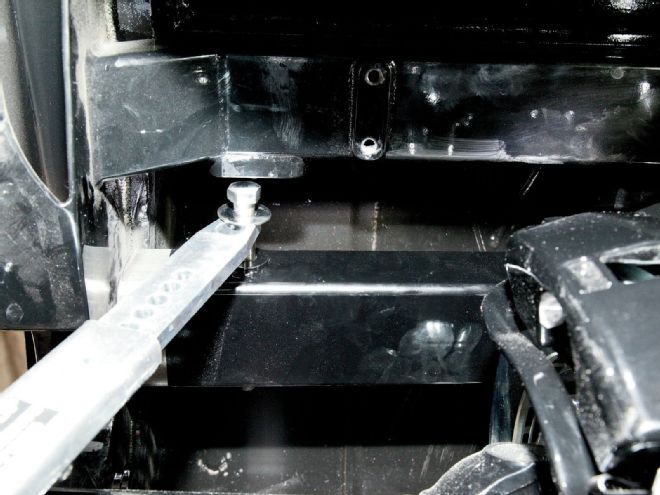 11. During mock-up it was discovered the new crossmember would have to be stepped in order to get the car to sit where Kugel wanted it to. The old crossmember is left in place.
11. During mock-up it was discovered the new crossmember would have to be stepped in order to get the car to sit where Kugel wanted it to. The old crossmember is left in place.
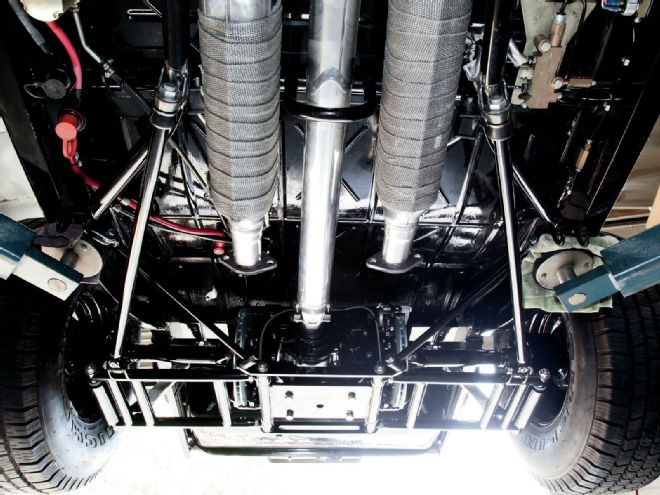 12. The Kugel IRS in place, but the exhaust still needs to be modified to run above the control arms rather than underneath them.
12. The Kugel IRS in place, but the exhaust still needs to be modified to run above the control arms rather than underneath them.
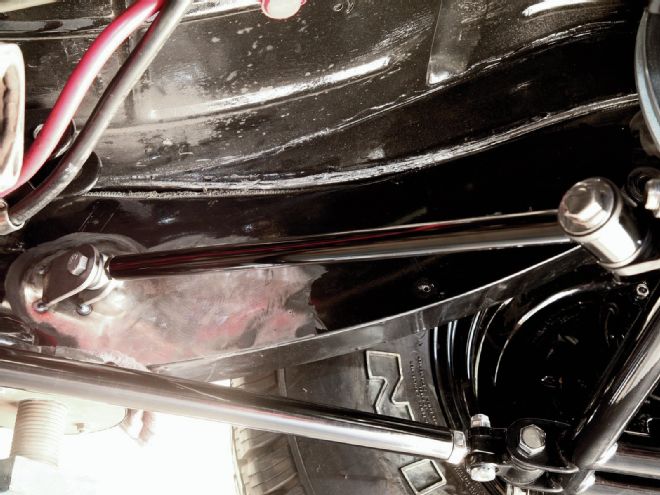 13. The pinion support rods mount roughly 45 degrees off the centerline of the carrier.
13. The pinion support rods mount roughly 45 degrees off the centerline of the carrier.
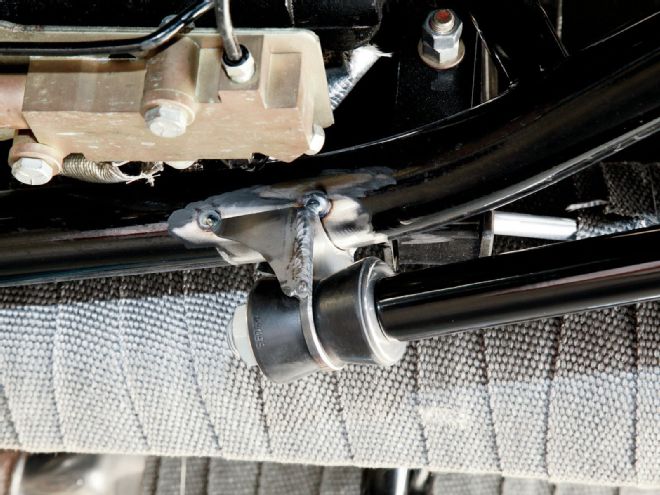 14. The radius rod, which runs between the outside edge of the control arm to the middle area of the X-member, is attached at its forward section by small tabs (supplied by Kugel) and should be level with the lower control arms.
14. The radius rod, which runs between the outside edge of the control arm to the middle area of the X-member, is attached at its forward section by small tabs (supplied by Kugel) and should be level with the lower control arms.
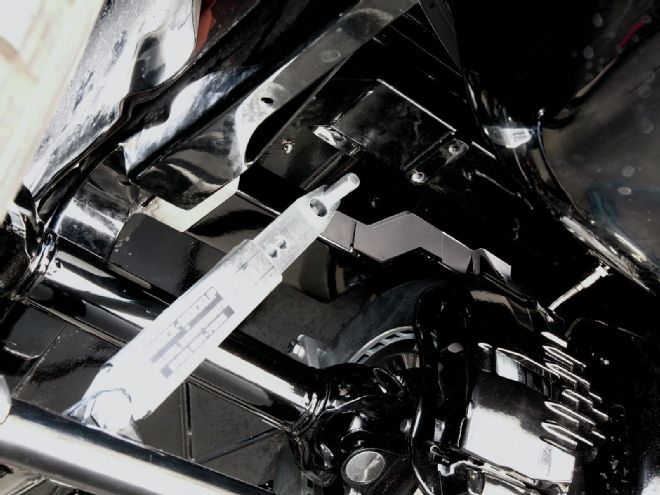 15. Looking up into the IRS from the driver side and past the Kugel Shock Mock-Up (about $60 a pair), you can see where the new crossmember has been stepped (arrow).
15. Looking up into the IRS from the driver side and past the Kugel Shock Mock-Up (about $60 a pair), you can see where the new crossmember has been stepped (arrow).
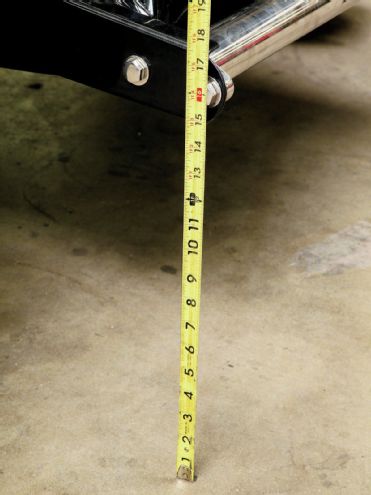 16. After the IRS is installed, the wheels bolted back on, and the car set back down on all fours, you can see where the car now sits 1-1/2 inches higher in the rear...
16. After the IRS is installed, the wheels bolted back on, and the car set back down on all fours, you can see where the car now sits 1-1/2 inches higher in the rear...
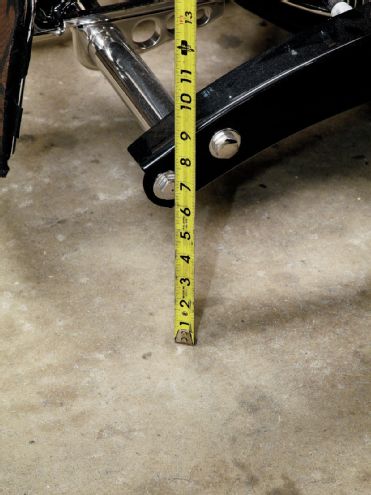 ...and 3/8 inch lower in the front.
...and 3/8 inch lower in the front.
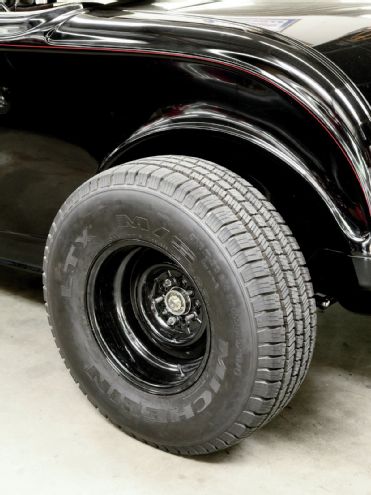 17. Though there are a lot of folks out there who would underestimate what these photos show, rear tire fitment in relation to the lines of the body is where many folks mess up the look of their ride.
17. Though there are a lot of folks out there who would underestimate what these photos show, rear tire fitment in relation to the lines of the body is where many folks mess up the look of their ride.
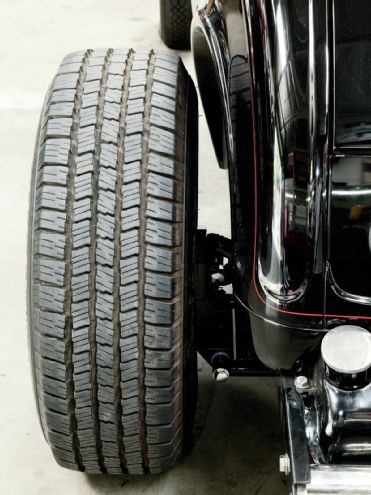 18. Tires should fit close to the body, but not close enough to rub the body, and the profile should fill up the arch of the wheelwell without riding up too high over the peak of the tire.
18. Tires should fit close to the body, but not close enough to rub the body, and the profile should fill up the arch of the wheelwell without riding up too high over the peak of the tire.
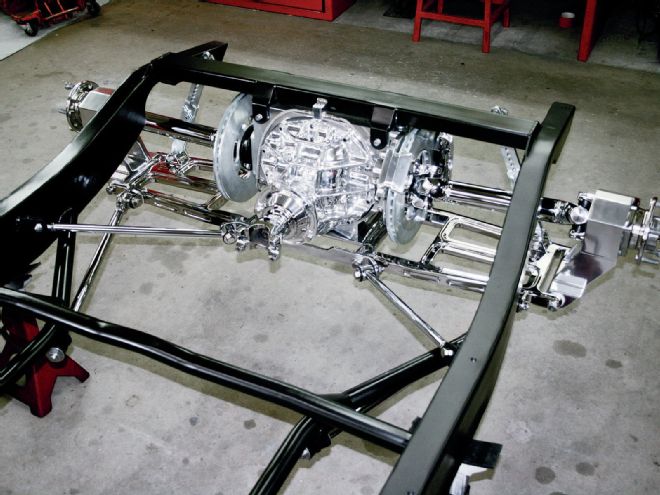 19. If you want to go all out, this is what the Kugel IRS system looks like when it has all the bells and whistles, including polished stainless steel and chrome steel pieces added.
19. If you want to go all out, this is what the Kugel IRS system looks like when it has all the bells and whistles, including polished stainless steel and chrome steel pieces added.
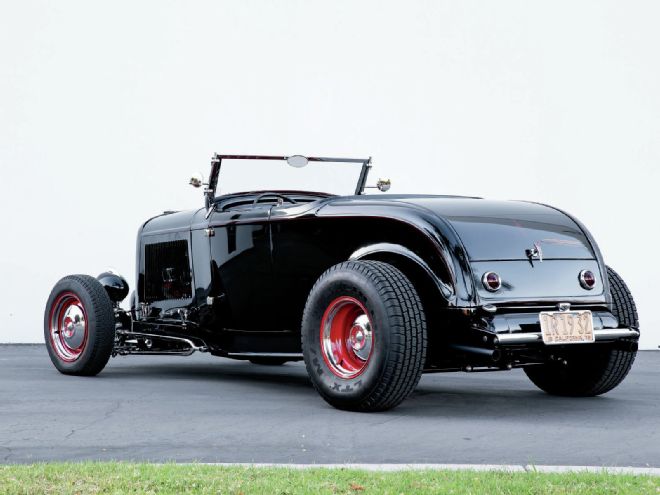 20. After all is said and done, this is the rear view of Jon Stroud’s 1932 roadster with the Kugel IRS in place. At first (or even second) glance you don’t notice there is a superior suspension system to the stock transverse or even coilover-based 9-inch-rear designs under this traditional-inspired roadster.
20. After all is said and done, this is the rear view of Jon Stroud’s 1932 roadster with the Kugel IRS in place. At first (or even second) glance you don’t notice there is a superior suspension system to the stock transverse or even coilover-based 9-inch-rear designs under this traditional-inspired roadster.